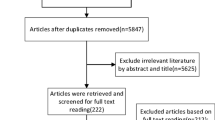Abstract
Background: In 1984, Yu Zhiheng proposed the “U-curve” regularity between urinary iodine (UI) and goiter prevalence (GP). However, along with the adjustment of salt iodine and iodine deficiency disorders (IDD), and surveys followed, some defects were found in the research. As a result, it is time to test and enrich the theory as a series of large sample survey data from China would be helpful. Aim: To test and enrich the theory of “U-curve” relationship between UI and GP. Subjects and methods: Based on the Chinese national IDD surveys (1999, 2002, 2005), the High Water Iodine survey of 2005, and the High Risk endemias survey of 2007, this article analyzed the relationship between UI and GP. The UI was grouped according to the World Health Organization (WHO) standard, self-defined (5 μg/l), and Yu Zhiheng’s level, separately, the GP was calculated for population with different UI level, the tendency curve was drawn and the fitting curve model was estimated by SPSS®. Results: For the 2005 Chinese national survey and 2005 High Water Iodine survey, we finally got the fitting curves and corresponding UI reference limits. Conclusions: The UI and GP formed a “U curve” relationship. It varied with some reasons and fell into an accurate U shape step by step. For High Water Iodine endemias survey, the relationship changed to “power curve”. Regarding the WHO recommended GP<5%, the UI range of school-age children in normal district should be 110–315 μg/l, whereas, in high water iodine district should be <80 μg/l.
Similar content being viewed by others
References
Hetzel BS. Iodine deficiency disorders (IDD) and their eradication. Lancet 1983, 2: 1126–9.
Todd CH, Allain T, Gomo ZA, Hasler JA, Ndiweni M, Oken E. Increase in thyrotoxicosis associated with iodine supplements in Zimbabwe. Lancet 1995, 346: 1563–4.
Stanbury JB, Ermans AE, Bourdoux P, et al. Iodine-induced hyperthyroidism: occurrence and epidemiology. Thyroid 1998, 8: 83–100.
Yu Z, Liu S, Zhu H, et al. Findings, confirming and establishment of epidemic law between iodine and goiter rate, Chinese Journal of Endemiology 2004, 23: 195–7.
World Health Organization. Iodine status worldwide, WHO global database on iodine deficiency. Geneva, 2004.
World Health Organization. Principles and methods for assessment of risks from essential trace elements. Geneva: WHO, 2002, 1–3.
Saggiorato E, Mussa A, Sacerdote C, et al; Piemonte Goiter Study Committee. Thyroid volume and urinary iodine excretion in the schoolchild population of a northwestern Italian sub-Alp metropolitan area. J Endocrinol Invest 2004, 27: 516–22.
Cetin H, Kisioglu AN, Gursoy A, Bilaloglu E, Ayata A. Iodine deficiency and goiter prevalence in Turkey after mandatory iodization. J Endocrinol Invest 2006, 29: 714–8.
Yu X, Fan C, Shan Z, et al. A five-year follow-up study of goiter and thyroid nodules in three regions with different iodine intakes in China. J Endocrinol Invest 2008, 31: 243–50.
Zimmermann MB, Ito Y, Hess SY, Fujieda K, Molinari L. High thyroid volume in children with excess dietary iodine intakes. Am J Clin Nutr 2005, 81: 840–4.
Delange F, Benker G, Caron P, et al. Thyroid volume and urinary iodine in European schoolchildren: standardization of values for assessment of iodine deficiency. Eur J Endocrinol 1999, 136: 180–7.
Toromanovic A, Tahirovic H. Thyroid volume and urinary iodine excretion in schoolchildren in North-Easten Bosnia. Eur J Pediatr 2004, 163: 270–1.
Zimmermann MB, Hess SY, Molinary L, et al. New reference values for thyroid volume by ultrasound in iodine-sufficient schoolchildren. IDD Newsletter 2003, 19: 62–4.
Tas F, Bulut S, Egilmez H, Oztoprak I, Ergür AT, Candan F. Normal thyroid volume by ultrasonography in healthy children. Ann Trop Pediatr 2002, 22: 375–9.
World Health Organization, United Nations Children’s Fund, International Council for Control of Iodine Deficiency Disorders. Assessment of iodine deficiency disorders and monitoring their elimination. A guide for programme managers, the third version. World Health Organization 2007.
Author information
Authors and Affiliations
Corresponding author
Rights and permissions
About this article
Cite this article
Liu, P., Liu, S.J., Su, X.H. et al. Relationship between urinary iodine and goiter prevalence: Results of the Chinese national iodine deficiency disorders survey. J Endocrinol Invest 33, 26–31 (2010). https://doi.org/10.1007/BF03346545
Accepted:
Published:
Issue Date:
DOI: https://doi.org/10.1007/BF03346545




